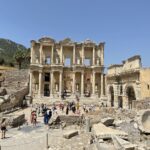The Temple of Artemis in Ephesus was one of the most magnificent and awe-inspiring structures of the ancient world. Recognized as one of the Seven Wonders of the Ancient World, this grand temple was dedicated to Artemis, the Greek goddess of the hunt, wilderness, childbirth, and fertility.
Although today only a few scattered ruins remain, the Temple of Artemis was once the largest temple in the world, surpassing even the Parthenon in Athens in both size and grandeur. The temple not only served as a religious sanctuary but also functioned as a major cultural, economic, and political center for the ancient city of Ephesus.
In this article, we will explore the history, architecture, cultural significance, destruction, and modern-day remainsof the Temple of Artemis, along with travel tips for those who want to visit this legendary site.

The History of the Temple of Artemis
The construction of the first Temple of Artemis dates back to around 550 BC, during the reign of King Croesus of Lydia, who was famous for his immense wealth. The temple was built in Ephesus, an important Greek city on the western coast of Anatolia (modern-day Turkey).
Why Was the Temple Built?
The Ephesians had a deep devotion to Artemis, their patron goddess. Unlike the typical Greek depiction of Artemis as a huntress, the Ephesian version of Artemis was associated with fertility and motherhood. She was often represented with multiple breasts, symbolizing abundance and nourishment.
The temple was built as both a place of worship and pilgrimage, attracting people from all over the ancient world. Over the centuries, the site grew into a major religious and economic hub, where merchants, artists, and traders gathered.
Architectural Marvel: Design and Structure
The Temple of Artemis was designed by the famous Greek architect Chersiphron and his son Metagenes. It was a truly colossal structure and one of the largest temples of its time.
Key Architectural Features:
– Size: 137 meters (450 feet) long and 69 meters (225 feet) wide, making it twice the size of the Parthenon.
– Columns: The temple had 127 massive marble columns, each standing 18 meters (60 feet) high. These columns were intricately decorated with carvings and reliefs.
– Materials: Built entirely from white marble, which reflected the sun beautifully and gave the temple a divine glow.
– Interior: The heart of the temple housed an enormous statue of Artemis, made of gold, silver, ebony, and black stone.
– Sacred Altars: Rituals, sacrifices, and religious ceremonies took place on the grand altars within the temple complex.
The rich artwork and sculptures within the temple were created by some of the most famous artists of the time, including Phidias, Polykleitos, Kresilas, and Phradmon.

Destruction and Reconstruction
Throughout history, the Temple of Artemis was destroyed and rebuilt multiple times. Each destruction marked a significant chapter in the region’s history.
Major Events in the Temple’s History:
– 356 BC – The First Destruction: The temple was set on fire by Herostratus, a man who sought eternal fame. Ironically, this event occurred on the same night that Alexander the Great was born.
– 334 BC – Alexander the Great’s Offer: Upon arriving in Ephesus, Alexander the Great offered to finance the reconstruction of the temple, but the Ephesians declined, stating that a god should not build a temple for another god.
– 3rd Century AD – The Goth Invasion: The temple was raided and severely damaged by the Goths, a Germanic tribe that attacked Asia Minor.
– 401 AD – Final Destruction by Christians: By this time, Christianity had become the dominant religion in the Roman Empire, and many pagan temples were destroyed. The Temple of Artemis was burned and completely dismantled by Christian zealots, led by St. John Chrysostom.
Cultural and Religious Significance
The Temple of Artemis was more than just a place of worship; it was the heart of Ephesian society.
– A Major Economic Center: The temple functioned as a bank, where people deposited their wealth for safekeeping. Many merchants conducted their business in the surrounding area.
– A Cultural Hub: The temple attracted artists, philosophers, and poets. Famous figures like Heraclitus and Callimachus wrote about the temple’s beauty and significance.
– A Pilgrimage Site: Devotees from across Greece, Rome, and the Near East traveled to Ephesus to offer sacrifices and prayers to Artemis.
– A Symbol of Power and Identity: The Ephesians took immense pride in their temple. It was depicted on coins, mosaics, and city emblems, symbolizing their cultural and religious identity.

The Temple of Artemis Today: Can You Visit It?
Although the Temple of Artemis no longer stands in its former glory, its ruins can still be visited near Selçuk, Turkey, a short distance from Ephesus Ancient City.
How to Visit the Temple of Artemis:
Location: Selçuk, İzmir Province, Turkey
How to Get There:
- From İzmir, take a train, bus, or car to Selçuk, which is about 1 hour away.
- The temple site is located just a few kilometers from Ephesus Ancient City, making it an easy stop on a historical tour.
- Best Time to Visit: Spring and autumn offer the most comfortable weather conditions.
Although only a few columns remain, the site is still a powerful reminder of its glorious past. Nearby, visitors can explore the Ephesus Archaeological Museum, where artifacts from the temple are displayed.
Conclusion
The Temple of Artemis was one of the greatest wonders of the ancient world, standing as a symbol of divine beauty, architectural excellence, and cultural significance. Though it has been lost to time, its legacy lives on in historical records, archaeological findings, and the admiration of those who visit its remains.
For history lovers, travelers, and mythology enthusiasts, a visit to Ephesus and the Temple of Artemis is a once-in-a-lifetime experience that brings the past to life.
To fully explore the Ancient City of Ephesus, be sure to read our other article!













Comments (1)